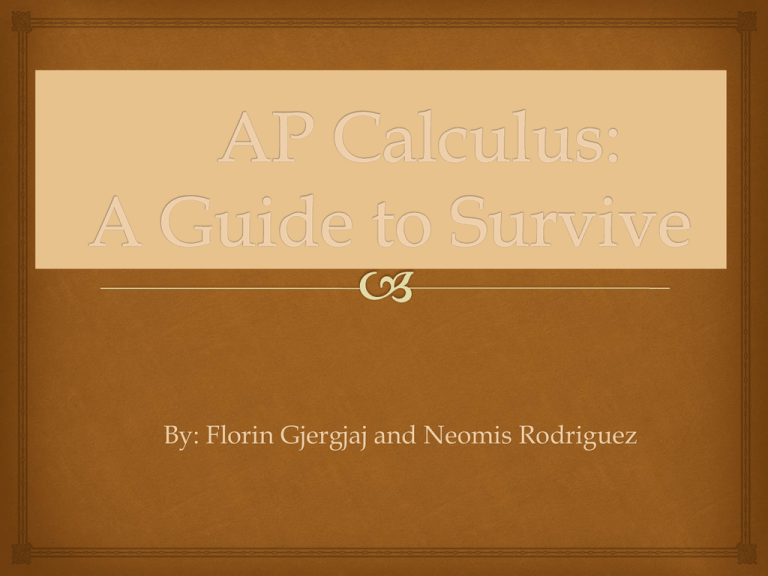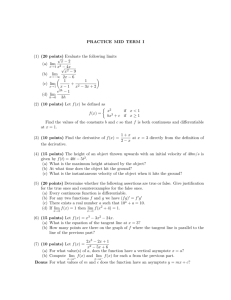A Guide to Survive
advertisement

By: Florin Gjergjaj and Neomis Rodriguez Table of Contents The Masterminded Authors Chapter 1: Limits and Continuity Chapter 2: Derivatives Chapter 3: Antiderivatives Chapter 4: Application Problem The Masterminded Authors Florin is known for having a difficult last name. He is a student at the High School for Environmental Studies. He defeated the formidable course known as AP Calculus AB, and he mastered all of the concepts. His academic goal is to conquer the BC course and master the concepts just as well. His long term goal is to go to NYU and achieve a medical career. The Masterminded Authors Neomis is known for having a difficult first name (if you think it’s easy, you’re probably pronouncing it wrong). She is currently a student at HSES with several AP classes. Her academic goals include mastering the Spanish language and pursuing a scientific career. Chapter 1: Limits and Continuity Limits A limit is the calculation of f(x) as x approaches a. The three criteria for a limit to exist are: 1. Lim f(x) exists (right) xa+ 2. Lim f(x) exists (left) xa3. Lim f(x) = Lim f(x) = L xa+ xaLimits can be found three ways: Numerically, Algebraically and Graphically Algebraically has three steps: Factor Simplify Substitute Graphically requires tracing from the right and the left. The f(x) must be the same number for both for the limit to exist. Numerically requires a table with x and f(x) values. It shows f(x) as x approaches a, from both the right and left. Algebraically Example: Lim x2 x–2 x² – x – 2 (x- 2) (factor the denominator out and cross out like terms) (x-2) (x+1) 1 (Simplify completely and then substitute 2 for x) (x+1) 1 = 1/ 3 ((2) + 1) Numerically requires plugging in x values that approach a to find f(x). Graphically requires tracing the graph from the left and right as x approaches a (requires the same value in order for the limit to exist) X 1.9 1.99 1.999 2 2.001 2.01 F(x) .345 .334 .333 .333 .332 .3322 Continuity Continuity (at a point and an open interval) requires no holes (limits), gaps, jumps and must be unbroken. The criteria for Continuity: 1. F(c) is defined 2. Lim f(x) exists xc 3. Lim f(x) = f(c) xc If it is not unbroken, it is discontinuous. There are two types of discontinuity: 1. Removable (with a limit) 2. Non-removable (without a limit) Continuous Discontinuous Chapter 2: Derivatives Definition of the Derivative using the Limit Process A derivative is the slope of a function at a point. Some derivative notations include: f ‘(x), dy/dx, y’, d/dx f(x) or dx [y]. The definition of tangent line with slope m is calculated using the formula Lim f(c + ∆ x) – f(c) = m ∆ x 0 ∆x The definition of a derivative using limit process is calculated using the formula F ‘(x) = Lim f (x + ∆ x) – f(x) ∆x0 ∆x The steps to solve are: 1. Substitute (x + ∆ x) for each x variable 2. Cross out opposite signs 3. Substitute for ∆ x Example: f(x) = x2 + 1 (0,1) Lim ∆x 0 (x + ∆x)2 + 1- (x2 + 1) ∆x Lim ∆x 0 x2 + 2∆x2 + ∆x2 + 1 – x2 – 1 ∆x Lim ∆x 0 2∆x2 + ∆x2 ∆x Lim ∆x 0 ∆x (2x + ∆x) ∆x Lim ∆x 0 (2x + ∆x) (2x + (0)) = 2x A Few Derivative Rules 1. Constant Rule d/dx [c] = 0 *The derivative of variables such as x and y is 1.* 2. Power Rule d/dx [xn] = nxn-1 This means that you move the exponent to the front and subtract 1. Ex. y = x3 is 3x2 3. Sine and Cosine d/dx [sinx] = cosx d/dx [cosx] = -sinx *Additional Trig Techniques* d/dx [tanx] = sec2x d/dx [secx] = secx tanx d/dx [cscx] = - cscx cot d/dx [cotx] = - csc2x Anything with a c is negative. * 4. Product Rule d/dx [ f(x) g(x)] = f ‘(x) g(x) + f(x) g’(x) Ex. (3x +1) * (5 + 4x) * f ‘(x) = 3 and g‘(x) = 4* f(x) g(x) 3 * (5 + 4x) + (3x +1) * 4 f ‘(x) g(x) + f(x) * g ‘(x) 15 + 12x +12x + 4 = 24x + 19 5. Quotient Rule d/dx [ f(x)/ g(x)] = g (x) f ‘(x) – f(x) g’(x) [g(x)]2 * For memorization: lo di hi – hi di lo over lo lo * Ex. 5x – 2 * f ‘(x) = 5 and g ‘(x) = 2x 2 x +1 [x2 + 1 * 5] – [5x – 2 * 2x] = [5x2 + 5] – [10x2 – 4x] (x2 + 1)2 (x2 + 1)2 = - 5x2 – 4x + 5 (x2 + 1)2 6. Chain Rule d/dx = f ‘ [g(x)] * g’ (x) This means that you multiply the original function by the derivative of the inside function. Ex. (2x2 + 5)7 (Power rule: move 7 to front and subtract 1.) 7(2x2 + 5)6 * 4x (Derivative of the inside is multiplied, inside left intact) 2 6 28x(2x + 5) Implicit Differentiation When you implicitly differentiate y variables require dy/dx. Ex. d/dx [y3] = 3y2 dy/dx Guidelines 1. Differentiate both sides with respect to x 2. Collect all terms involving dy/dx 3. Factor dy/dx to the left side 4. Solve for dy/dx Ex. y3 + y2 – 5y – x2 = - 4 3y2 dy/dx + 2y dy/dx – 5 dy/dx – 2x = 0 dy/dx (3y2 + 2y – 5) = 2x dy/dx = 2x 3y2 + 2y – 5 Rate of Change Rate = distance Average Velocity = ∆d time ∆t S (t) = Position Function S ‘(t) = Velocity (Find the derivative) V ‘(t) = Acceleration (Find the second derivative) A(t) = S ‘’(t) Ex. S (t) = 3x2 + 3 V(t) = 6x A(t) = 6 Chapter 3: Antiderivatives Antiderivatives vs. Derivatives Definite Integrals vs. Indefinite Antiderivative: a function F is an antiderivative of f on an interval I if F’(x) = f(x) for all x in I. An antiderivative is truly the inverse operation of the derivative. A definite integral expresses the difference between the upper and lower limits of the function. Example: An indefinite integral does not include the limits of the function. Example: Basic Integration Rules Accumulation Functions Accumulation functions shows how you can figure out the velocity and position of a function when you’re given the acceleration. You can find the velocity by finding the antiderivative of the acceleration. Then, to find the position of the object you have to find the antiderivative of the velocity. Ex. a(t) = 6 sec/min2, x(0) = 2 and v(0) = 5 v(t) = 6dt v(t) = 6t + c (plug in initial condition to solve for c) s(t) = 6t 5dt s(t) = 6t + 5t + c (plug in initial condition again) s(t) = 6t+5t+2 Chapter 4: Application Problem How Calculus Relates to Physics Calculus can be applied to Physics in terms of velocity, acceleration and position. Ex. A model rocket is fired vertically upward from rest. Its acceleration for the first three seconds is a(t) = 60t at which time the fuel is exhausted and it becomes a freely “falling” body. Fourteen seconds later, the rocket’s parachute opens, and the (downward) velocity slows linearly to -18ft/second in 5 seconds. The rocket then “floats” to the ground at that rate. At what time does the rocket reach its maximum height? The rocket accelerates for the first three seconds. Hence, the rocket reaches its maximum height at t = 3 seconds. What is the height? A(t) = 60t therefore to find the velocity you find the antiderivative of a(t). V(t) = 30t2 +c. To find the height you must find the antiderivative of the velocity D(t) = 10t2 +C. Using three seconds as your maximum height, D(3) = 270 meters.







